 |
 |
IBRI Paper (2001)
The Star of Bethlehem:
A Natural-Supernatural Hybrid?
Robert C. Newman
Biblical Theological Seminary
Interdisciplinary Biblical Research Institute
Copyright © 2001 by Robert C Newman. All rights reserved.
Numerous suggestions have been made over the centuries for the
identity
of the star that led the Magi to Jesus. Some of these proposals may be
classified as purely natural, in that no miraculous intervention is
postulated
- e.g., Halley's comet, some other comet, one or more of various
planetary
conjunctions, or an exploding star, such as a supernova. Other
proposals
can be labeled purely supernatural, since they suggest that a
miraculous
object - perhaps an angel, the Shekinah glory, or some other localized,
movable bright light in the sky - was responsible for the phenomenon.
The advantage of this first class of proposals is that it may be
possible
to find other historical references to the object, or (for Halley's
comet
or planetary conjunctions) to re-enact the scenario using modern
computers.
The problem with such proposals is that the bright object, being
millions
of miles out in space, does not naturally fit Matthew's comment that
the
star led the Magi to the place where the child was. Supernatural
models,
on the other hand, can be easily imagined in which a relatively local
bright
object will do the guiding. But it would be very unlikely that such an
object would leave any extra-biblical traces in the historical record.
Here we propose a hybrid model - part natural and part supernatural
- that both leaves a distinctive mark for us to investigate two
thousand
years later, and which will also fit a straight forward reading of
Matthew's
account. Our proposal involves a modification of Ernest Martin's
interpretation
of a series of planetary and stellar conjunctions, to which is added a
localized bright object that would have been recognized by the Magi as
the "same" star and which, on that crucial night, led them to the house
where the baby Jesus was.
The Natural Part
Retrospective calculations of planetary positions for ancient times
have occasionally been made since the time of Johann Kepler (d 1630).
But
such efforts (being done by hand) were enormously time-consuming,
exacting
and tedious until very recently. An early fruit of the development of
electronic
computers was the publication in 1962 of Bryant Tuckerman's tables of
Planetary,
Lunar and Solar Positions 601 BC to AD 1 by the American
Philosophical
Society. In the following years, Roger Sinnott worked carefully through
these tables and located all the close planetary conjunctions that
occurred
around the probable time of the birth of Jesus. In particular, Sinnott
found one strikingly close conjunction of Venus and Jupiter in the
constellation
of Leo (the Lion) on the evening of 17 June 2 BC, which would have been
quite rare. He proposed that this was the Christmas star, publishing
his
results in the December 1968 issue of Sky and Telescope, the
premier
magazine for amateur astronomers. His suggestion has since been adopted
and presented each Christmas in many planetarium programs. Ernest
Martin
went on to develop the suggestion with much additional detail and
historical
research in his book The Star That Astonished the World.
Martin noticed a cluster of additional conjunctions involving one or
the other of these two planets within a year of this conjunction. He
suggested
that these would have had such symbolic significance as to send the
Magi
to Judea to look for the newborn king of the Jews.
|
(adapted from The Star That Astonished the World, p 56) |
|||
|
day-mo-year (BC) |
Babylon/Jerusalem |
Conjunction |
(arc minutes) |
|
|
|
|
|
|
|
|
|
|
|
|
|
|
|
|
|
|
|
|
|
|
|
|
|
|
|
|
|
|
|
|
|
|
|
Martin suggests that these conjunctions above, plus a configuration
of sun and moon with the constellation Virgo on 11 Sept 3 BC, would
have
been read as follows:
12 August 3 BC. Jupiter, the king planet, having left the Sun, the supreme Father, is now conjoined with Venus, the mother. The Sun, Moon and Mercury (the messenger) are also located with Jupiter and Venus in Leo, the lion, representing the tribe of Judah (Gen 49:9; see fig. 1). The message of this configuration: some important royal event is to happen among the Jews.
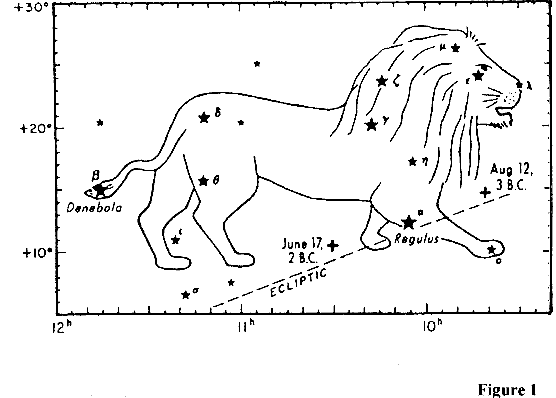
31 August 3 BC. Mercury, the heavenly messenger, having left the
Sun,
now arrives at Venus, the mother. The Sun is now in the constellation
Virgo,
the virgin. Mercury and Venus are in Leo and Jupiter is just entering
the
same. Message: God's messenger is sent to the mother.
11 September 3 BC. One of the visions in Revelation, that of the woman about to give birth in chapter 12, verses 1-5, can easily be understood astrologically to mark an exact date. If the woman is taken to be the constellation Virgo, the virgin, then the Sun clothes her body for about one month per year. The moon will pass through that region in the course of its monthly cycle so that it is (just) under her feet on one particular day. In 3 BC, that day is September 11. Martin takes this to be the date of Jesus' birth. See fig. 2.
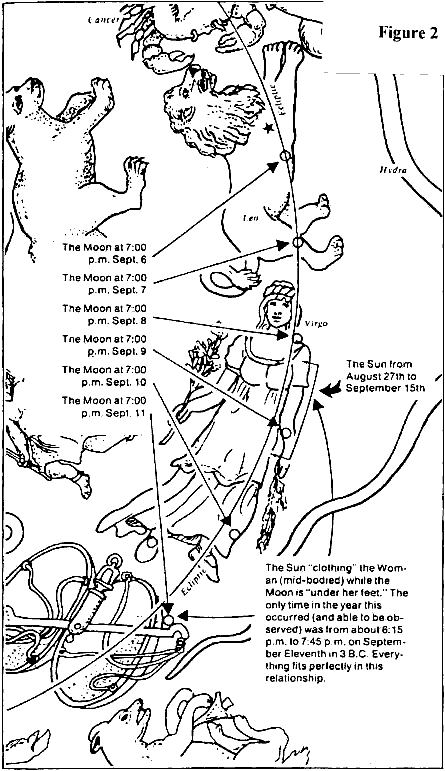
14 Sept 3 BC, 17 Feb 2 BC, and 8 May 2 BC. Three conjunctions of
Jupiter
with Regulus, the brightest star in the constellation Leo, the lion,
and
located between the lion's feet. Martin notes the prediction in Gen
49:10:
"The scepter will not depart from Judah nor the ruler (or ruler's
staff)
from between his feet, until he comes to whom it belongs and the
obedience
of the nations is his." Jupiter, the king planet, circles above
Regulus,
the king star, placing a crown on the king star. See fig. 1.
17 June, 2 BC. A very rare close conjunction of Jupiter and Venus,
which
are variously estimated to have a separation of 3 minutes of arc
(Sinnott),
0.5 minute (Martin), or 0.1 minute (Carroll). The frequency of such a
close
conjunction (depending on which estimate is correct) would range from
once
in about 1150 years to once in about 34 thousand years. See my
calculations
in the appendix. Martin sees this conjunction as having the same
significance
as the one of 12 Aug 3 BC, and suggests it was this 17 June conjunction
that sends the Magi on their way, arriving in Jerusalem about December
25.
26 August 2 BC. A close conjunction of Jupiter and Mars (war) in
Leo,
with Venus and Mercury also in Leo, and the Sun in Virgo. Martin
suggests
this sign may mean these events will lead to war.
Recently I have noticed a number of things about these conjunctions
that point to a modification of Martin's view. When these changes are
made,
the symbolism of this sequence of events suddenly snaps into focus in a
remarkable way.
1. Martin's 11 September event comes only two weeks after the 31
August
conjunction, in which God's messenger comes to the mother. This 31
August
event sounds like Gabriel's annunciation to Mary, which would hardly be
just two weeks before the birth.
2. Taking 11 September as the conception, then the really close
conjunction
of 17 June is just over nine months later. This makes best sense as the
birth event, which (after all) is what Matthew 1-2 is all about. So
Jesus
is born 17 June 2 BC.
3. This arrangement gives a different flavor to the three
conjunctions
of Jupiter with Regulus, as the baby Jesus is in Mary's womb at this
period.
Thus Jupiter can be seen as God hovering over him. As an unexpected
benefit,
the name Regulus is the Latin diminutive of Rex, "king." So the king
planet
is hovering over the little king!
4. The 26 August 2 BC massing of planets - all the anciently-known
planets
but Saturn clustered within a few degrees of one another in the space
between
Leo and Virgo (Sun, Moon, Mercury, Venus, Mars, Jupiter) - may indeed
imply
war, as Martin suggests, given the presence of warlike Mars for the
first
time in this sequence of conjunctions. If we assume with Martin that
the
Magi set out from Babylon (or thereabouts) at the really close
conjunction
of 17 June, they would have just 70 days to get to Judea by this date.
This is not unreasonable if they didn't dawdle. See the appendix. My
scheme
thus looks like this, with a date or two adjusted to fit the results of
my own planetarium program:
12 August 3 BC. Jupiter, the king planet, joins with Venus, the mother, in Leo. An important royal event - presumably a birth - is about to occur in Judah. See fig. 3.
26 August 3 BC. Mercury, the heavenly messenger, comes to Venus the mother. The message is delivered to the mother-to-be. See fig. 4.
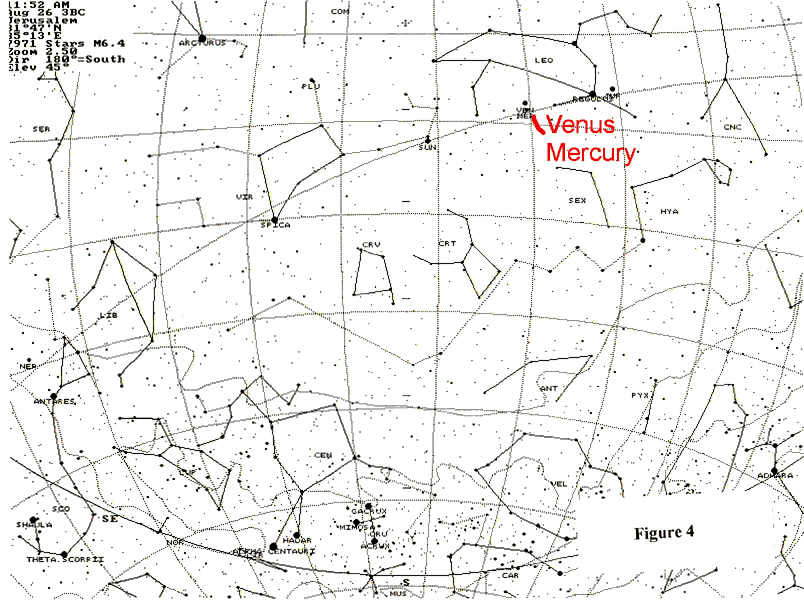
11 September 3 BC. The Sun clothes the body of the Virgin while the Moon is under her feet. The conception of the child. See figs. 2 and 5.
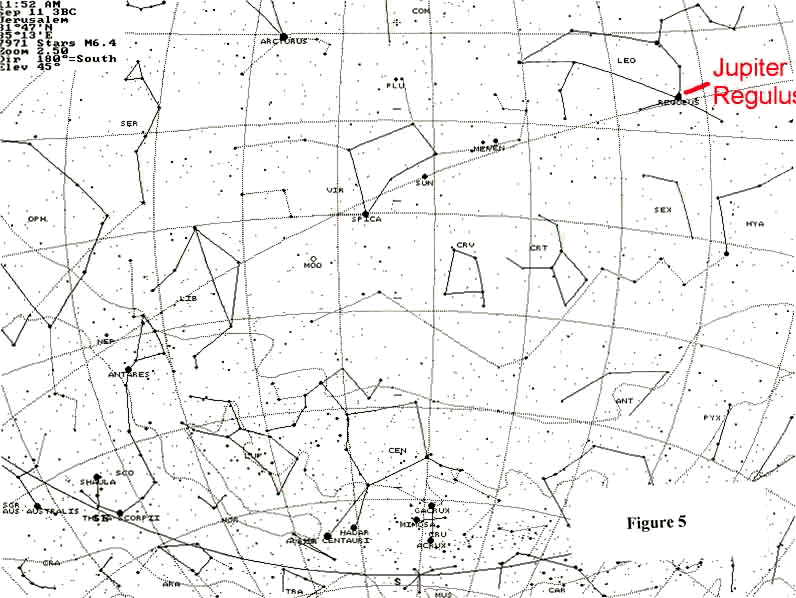
14 September, 17 February and May 8, now 2 BC. Jupiter the king planet hovers over Regulus, the little king, who is in his mother's womb.
17 June 2 BC. The rare close conjunction of Jupiter with Venus in Leo, almost exactly the same distance East of Regulus as the earlier 12 August 3 BC conjunction was West of Regulus. See fig. 1. The birth. The Magi set out for Judea and Jerusalem, its capital. See fig. 6.
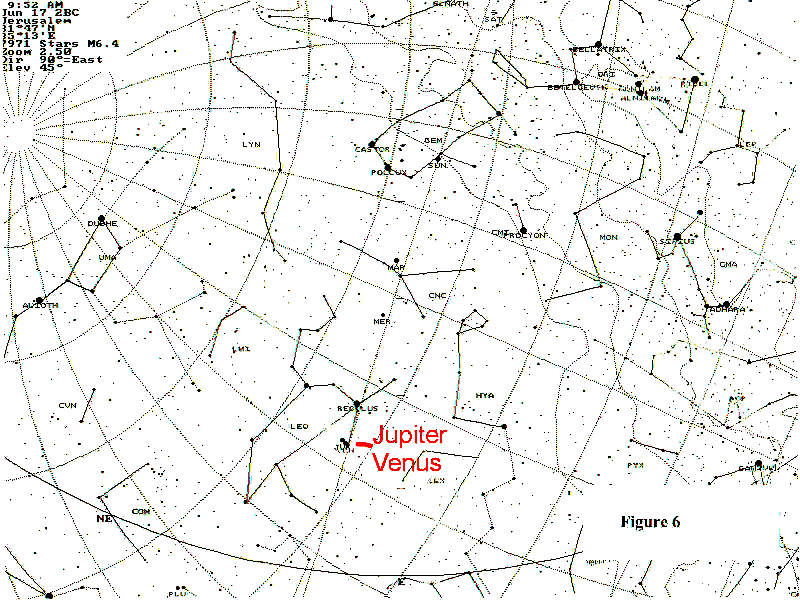
28 August 2 BC. The clustering of Sun, Moon, Jupiter, Venus, Mercury and Mars. This means war. The Magi arrive, and Herod makes his move to kill the baby Jesus. See fig. 7.
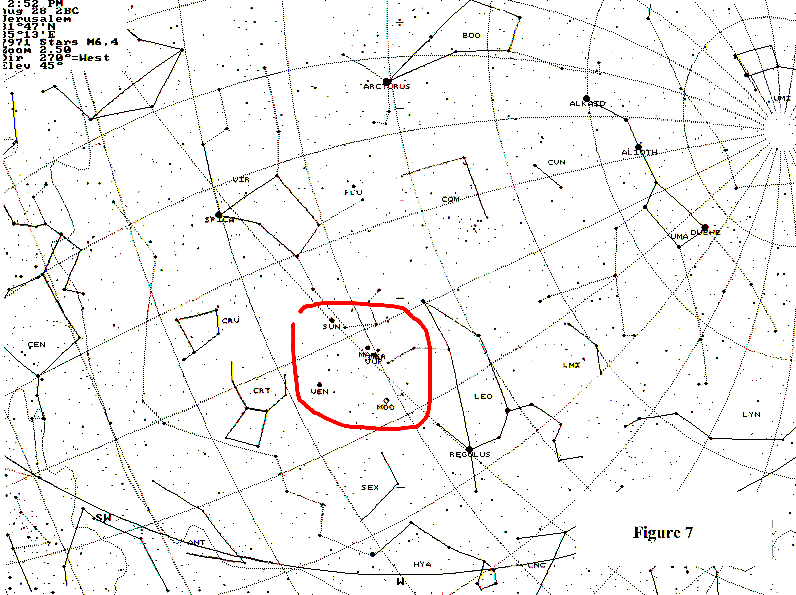
How rare is the sequence of events we are considering here? As noted above, this will depend on the separation of Jupiter and Venus at the close conjunction of 17 June 2 BC. With Sinnott's suggested separation of 3 minutes, this sort of conjunction will occur in Leo about every 1154 years. With Martin's separation of 0.5 minute, it will occur about once every 6923 years. With Carroll's separation of 0.1 minute, once every 34,615 years.
The event is seen to be even rarer when we add in the triple
conjunction
of Jupiter with Regulus, which only occurs in this particular year
because
the eleven degree wide loop made by Jupiter at opposition happens to
lie
across the position of Regulus. This has a probability of 11 degrees
divided
by 360 degrees, or about .03. Thus the frequency of this close
Jupiter-Venus
conjunction plus the triple conjunction with Regulus can be expected to
happen once every 38 thousand years (Sinnott), every 228 thousand years
(Martin), or every 1 million 142 thousand years (Carroll). A rare event
indeed!
The symbolism of these events (and their chronological order) is also impressive:
12 August 3 BC. Magi pay attention! A royal birth in Judah.
26 August 3 BC. The heavenly messenger informs the mother.
11 September 3 BC. The conception occurs.
The triple conjunction. The king of the gods hovers over the little king.
17 June 2 BC. The birth occurs.
28 August 2 BC. This means war.
The apologetic value of this sequence of events - which can easily
be
reconstructed two thousand years later by anyone on a home computer
using
a planetarium program - is enormous.
The Supernatural Part
The purely natural models tend to run aground in dealing with the
text
of Matthew 2:9-10:
(9) After they had heard the king, they went on their way, and the star they had seen in the east went ahead of them until it stopped over the place where the child was. (10) When they saw the star, they were overjoyed.
The problem here is that objects at astronomical distances cannot
guide someone to explicit places on the surface of the earth by mere
movement
alone. Instead this is characteristic of objects that are only a few
tens
of feet above the ground, as for example, the pillar of cloud and fire
in the wilderness.
Martin's model takes the verb "stopped" to be used in a technical
astronomical
sense, for Jupiter ceasing its westward motion relative to the stars,
and
beginning to move eastward once more, which he sees as happening about
25 Dec 2 BC, when he believes the Magi were at Jerusalem. This is
nothing
an observer would notice by watching Jupiter that night. Its stopping
would
only become apparent over the course of many nights as its relative
motion
among the stars would gradually come to a halt and then change
direction.
And "stopped over the place" Martin takes to mean that when the Magi
came
out of Jerusalem that night to go to Bethlehem, they saw Jupiter
"stopped"
in the southern sky over the village of Bethlehem, not over the
particular
house in which the baby Jesus was located. Since the Magi would need to
know that Jupiter had reached its stopping point (before moving east
again)
by means of calculations or charts they had prepared in advance, they
would
hardly be surprised or overjoyed as Matthew tells us they were. This
Greek
expression is quite emphatic.
Another suggestion for using an astronomical object to mark a
location
on the surface of the earth appears in E. W. Maunder's article on the
"Star
of the Magi" in the International Standard Bible Encyclopedia
(1939)
5:2849, under the section "The Legend of the Well." Maunder reports a
legend
at Bethlehem that one of the Magi, looking down into the well at the
inn,
saw the star reflected in it (so directly overhead) and knew they had
come
to the right place. This is a clever suggestion, but it hardly does
justice
to the details of the text of Matthew.
Supernatural models, by contrast, handle this problem easily. An
object
which is only a few tens of feet above the earth can easily guide
people
by moving at a speed they can keep up with and by stopping over the
location
to which the people are being led. In fact, the terminology used in the
ancient Greek translation of the Old Testament to describe the guidance
provided by the pillar of fire and cloud is rather close to that used
by
Matthew here. Matthew uses the verb proago to indicate that the
star "went before" them or "led" them, the verb erchomai to
indicate
its "moving" or "coming" and histemi to indicate its "stopping"
or "standing." In Exodus 13:21 God "leads" them (ago) by a
pillar
of cloud to show Israel the way. In Ex 14:19 the angel of God "goes
before"
them (proerchomai), and to protect them from the Egyptians, he
moves
the pillar of cloud to "stand" (histemi) behind them. In Ex
33:9,
whenever Moses would enter the tent of meeting, the pillar of cloud
would
descend and "stand" (histemi) at the door of the tent, and when
the people saw the pillar "standing" (histemi), they would each
stand at the door of their own tents and worship. In Numbers 14:14,
Moses
tells God that the Egyptians have already heard that God's cloud
"stands
over" Israel (ephistemi) and that by or in the pillar of cloud
He
"goes before" them (poreuomai proteros). The verb poreuomai
is pretty much a synonym of erchomai. In Deuteronomy 1:33,
Moses
rebukes Israel for not trusting God who "went before" (proporeuomai
proteros) them in fire by night and cloud by day to search out
places
to camp and show them the way they should go.
So. With a purely natural model, no ordinary reading of the text of
Matthew or the phenomena of conjunctions will guide the Magi to Jesus.
In a purely supernatural model, this is handled easily, but the events
described above in our section "The Natural Part" are just an
astonishing
(but meaningless) fluke. But how about a hybrid model? The natural part
is open to retrospective calculation, while the supernatural part fits
the Matthew narrative naturally and gets the Magi to the right house in
Bethlehem. Such a natural-supernatural hybrid might also make sense of
the extreme joy which the Magi experience when they see the star again.
Matthew 2:9-10 tells us that they again saw the star which they had
seen in the east, so there is a strong indication that we are to
identify
the star they now see with that which sent them on their way. In the
model
we propose, if they arrive in Jerusalem on or about 28 August of 2 BC,
then the cluster of Sun, Moon, Mercury, Venus, Mars and Jupiter in
Leo-Virgo
will set with the Sun; in fact the Sun, being the easternmost member of
this group, will set last. So if we imagine the Magi coming out of
Jerusalem
as or shortly after the Sun sets, we can construct a scenario that
would
work very well.
Suppose (we speculate) they see a supernatural light about the size
and brightness of the Jupiter-Venus conjunction of 17 June. It arises
in
the west from where the Sun has just set and comes toward them until it
is low overhead. The "star" then turns southward and leads them (like
the
pillar in the wilderness) until it stops over the house where Joseph,
Mary
and the child Jesus are now living. After all their travels, wouldn't
that
be something to make the Magi "rejoice exceedingly with great joy" (a
literal
approximation to the Greek)?
That is my proposal for a reconstruction of the phenomenon of the
Christmas
star.
Sources
Carroll, Susan S. "The Star of Bethlehem: an Astronomical and Historical Perspective," 1998 <http://sciastro.net/portia/articles/thestar.htm> accessed 26 Sept 2000.
Chester, Craig. "The Star of Bethlehem," Imprimis (December, 1993): 1-4.
Martin, Ernest L. The Star That Astonished the World. Portland, OR: ASK Publications, 1991.
Maunder, E. W. "Star of the Magi," International Standard Bible Encyclopedia (1939).
Sinnott, Roger. "Thoughts on the Star of Bethlehem," Sky and Telescope (December 1968): 384-386.
Tuckerman, Bryant. Planetary, Lunar, and Solar Positions 601 B.C. to A.D. 1. Philadelphia: American Philosophical Society, 1962.
My simulations of the sky were made using the program SkyGlobe 3.6 for DOS, copyright 1993, Klass M Software.
My calculations for the frequency of conjunctions of Jupiter and
Venus
were made using my own program FCONJ, written in QBasic 4.5.
Appendix
Calculating the Frequency of Close Conjunction:
(Astronomical data from World Almanac '97: 455)
The Jupiter Venus separation of our conjunction is variously
estimated
as 3' (Sinnott), 0.5' (Martin), or 6" = 0.1' (Carroll). This will give
us a range of frequencies.
The inclinations of orbits of these planets to the ecliptic:
I(Jupiter) = 1deg 18' 17" = 78' I(Venus) = 3deg 23' 41" = 204'
so the separation of Jupiter and Venus at a conjunction can range
from
0' to 282'. Assuming an equal probability for each separation, the
fraction
of conjunctions as close or closer than ours is:
F(Sinnott) = 3'/282' = 1/100
F(Martin) = .5'/282' = 1/600
F(Carroll) =.1'/282' = 1/3000
How often do Jupiter and Venus have a conjunction? I attempted in
several
ways to make a diagram from which a simple calculation could be made,
but
did not get consistent results. So I tried two alternatives. (1) I used
my computer planetarium program to look at the number of conjunctions
in
the past ten years, and found 12 or 13 (one case being too close to
call),
for an average of 1.25 per year. But this is not long enough to give an
accurate average. (2) I set up a computer simulation in which three
planets
travel in circular orbits around the Sun at the average distances and
speeds
of Venus, Earth and Jupiter, respectively, and counted the number of
times
Jupiter and Venus would be in the same direction from Earth. This was
run
for 100,000 days (about 275 years), and gave an average of about 1.04
per
year. I believe this second method is closer to the correct value, as
the
number of conjunctions seems to fluctuate rather substantially over
shorter
periods of time. Let us use 1.04 per year.
But only 1/100 of these conjunction are close enough to match or
better
the separation calculated by Sinnott, or 1/600 for Martin's, or 1/3000
for Carroll's. In addition, to have the conjunction occur in the proper
constellation, there is only one chance in 12, so frequency f of
conjunctions
is:
f(Sinnott) = (1.04)(1/100)(1/12) = 1/1154, one conjunction in every 1154 years.
f(Martin) = (1.04)(1/600)(1/12) = 1/6923, one in every 6923 years.
f(Carroll) = (1.04)(1/3000)(1/12) =1/34615, one in every 34,615
years.
Add to this the requirement for a triple conjunction of Jupiter with Regulus. My computer planetarium program (SkyGlobe 3.6) shows that Jupiter has a "loop" at opposition of about 11 degrees, so to have this loop intersect Regulus has a probability of 11 deg/360 deg, or .03.
This decreases the frequency of the event we are describing to:
f(Sinnott) = (1/1154)(.03) = 1/38082, one such in every 38,082 years
f(Martin) = (1/6923)(.03) = 1/228492, one such in every 228,492 years
f(Carroll) = (1/34615)(.03) = 1/1142460, one such in every 1,142,460
years.
Travel-Time for the Magi:
In Ezra 7:9 we have information on the travel of Ezra from Babylon
to
Jerusalem in the fifth century BC. According to the conversion of dates
recorded in the New Living Translation, Ezra left Babylon on
April
8 and arrived in Jerusalem August 4. This is just under four months or
about 120 days.
Applying this travel-time to the Magi, if the close conjunction of
June
17, 2 BC was the event that moved them to journey to Jerusalem, then
they
would have set out sometime after this date. Traveling at about the
same
speed as Ezra's entourage, they would have arrived no earlier than
mid-October.
To get Martin's arrival date of December 25, we must assume that
they
spent over two months longer than this, either in preparation for
departure
or in travel. This is possible, but seems rather long.
But Ezra's group was quite large, and so moved rather slowly. The
Magi,
by contrast, may have felt the need to hurry. If they averaged 10 miles
per day, they could have traveled 700 miles by the 26 Aug conjunction;
if they averaged 15 miles per day, 1050 miles; if 20 miles per day,
1400
miles. From the Macmillan Bible Atlas map #243, it looks like
the
total distance from Babylon to Jerusalem (up the Euphrates and across
to
Palmyra, then via Damascus) is about 3 inches on the map, or about 760
miles using the scale given there. This is doubtless somewhat of an
underestimate,
as the roads are not as straight as a ruler, but it looks like the Magi
could easily have made the trip in 70 days if they averaged between 10
and 15 miles per day, not at all difficult if they were riding horses
or
camels.
Captions For Figures
Figure 1: The constellation Leo (the Lion), showing the location of its chief star Regulus and the two close Jupiter-Venus conjunctions of 12 August 3 BC and 17 June 2 BC. Adapted from a figure in Roger Sinnott's article "Thoughts on the Star of Bethlehem," Sky and Telescope (December 1968): 384-386.
Figure 2: The Zodiac in the vicinity of Leo (the Lion) and Virgo (the Virgin), showing the location of the Sun and Moon in early September 3 BC. Martin identifies 11 September 3 BC as the date of the birth of Jesus. I see it as the date of Mary's conception, and thus the incarnation of Jesus. Figure from Ernest L. Martin, The Star That Astonished the World (Portland, OR: ASK Publications, 1991).
Figures 3-7: Star charts of the various conjunctions as
viewed
from Jerusalem, reconstructed by the planetarium program SkyGlobe 3.6.
Planet names are given in three-letter abbreviations (SUN, MOO, MER,
VEN,
MAR, JUP), as are the constellation names (LEO, VIR).
EDITOR'S NOTE
| Although the author is in agreement with the doctrinal statement of IBRI, it does not follow that all of the viewpoints espoused in this paper represent official positions of IBRI. Since one of the purposes of the IBRI report series is to serve as a preprint forum, it is possible that the author has revised some aspects of this work since it was first written. |
Last updated: January 14, 2002